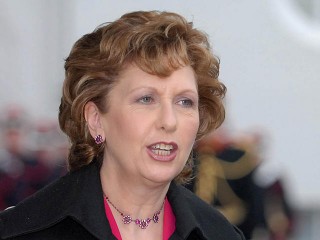
Mary McAleese biography
Date of birth : 1951-06-27
Date of death : -
Birthplace : Belfast, Northern Ireland
Nationality : Irish
Category : Politics
Last modified : 2010-07-22
Credited as : Politician and former barriester, President of Ireland, World's political leader
2 votes so far
McAleese is Ireland's second female president and the world's first woman to succeed another woman as an elected head of state. She was first elected president in 1997 and won a second term, without a contest, in 2004. Her birth in Belfast means she is the first President to have come from Northern Ireland. She is a member of the Council of Women World Leaders. In 2009, Forbes named her among the 100 Most Powerful Women in the world.
The nation of Ireland has been dogged by generations of conflict between the Protestant unionists who want Northern Ireland to remain under British control, and Catholic nationalists who have long fought for a united Ireland. Mary McAleese is the first Irish president to hail from British-ruled Northern Ireland. McAleese, wrote Kevin Cullen in the Boston Globe in 1997, "is hard to label. She considers herself both a devout Roman Catholic...and a committed feminist...She is also an ardent Irish nationalist. McAleese is hybrid, part of a minority that has lived on both sides of the border."
Her Country's Pain Drove Her Success
Born and raised in Northern Ireland in Ardoyne, a Catholic enclave in Protestant-dominated Belfast, McAleese witnessed first hand the violence of Ireland's longstanding religious wars. Catholics were treated as second-class citizens in Belfast, and often were tortured or killed. McAleese lost friends and family to bombs and gunfire, her father's business was bombed and her deaf brother once crawled home after being beaten, almost to death.
When McAleese expressed her childhood desire to become a lawyer, her parish priest--a friend of her father's--dismissed the notion, telling her it was a pipe dream because she was female. Her mother, upon hearing this exchange, yanked the priest's chair out from under him, sent him out the front door, and told young McAleese to ignore him. "It was the only advice I ever received from either parent on career choice!" McAleese is quoted as saying online at the For a Change Magazine website.
McAleese went on to earn her law degree from Queen's University in Belfast in 1973, her master's degree at Trinity College in Dublin, and a diploma in Spanish at the Institute of Linguists. "McAleese expressed her nationalism by succeeding in school and in the workplace," according to Boston Globe writer Kevin Cullen in 1998. "Her ambition was apolitical in the party sense, but fired by a determination to show that Catholics could be as smart and as industrious as Protestants."
McAleese was appointed as Reid Professor of Criminal Law, Criminology and Penology at Trinity College in 1975. She married Martin McAleese, a dentist, in 1976, and they have three children. She left academia in 1979 for two years to work as a journalist and anchorperson for Radio Telefis Eireann (RTE), the Irish national broadcasting service. She then served as director of the Institute of Professional Legal Studies at Queen's University before becoming pro vice-chancellor of the university.
Overcame Irish Secularism
In 1997, McAleese was a candidate in an election she was not even eligible to vote in--though they are eligible to run for office, Northerners have no say in the country's politics. Critics dimissed her candidacy, claiming that a Northerner could have no understanding of the issues of the Southern Irish. Some unionists, especially men, considered her uppity. Some went so far as to try to align her with Sinn Fein, the political party of the Irish Republican Army (IRA). The Chicago Tribune suggested that the likelihood of a Northern Ireland resident becoming president of Ireland was akin to the notion of "Americans electing a Canadian president of the United States." But, her supporters outvoted her detractors by the widest margin ever in a presidential election. McAleese moved into Aras an Uachtarain, Ireland's presidential mansion in the South, after winning 59 percent of the vote.
McAleese succeeded Mary Robinson, Ireland's first female president, after Robinson resigned to become the United Nations commissioner for human rights. "[McAleese] has a tough act to follow," said the Boston Globe in 1998. During her presidency, Robinson had reinvented the nation's presidency from a mostly ceremonial post, and became a serious figure in international politics when she took the United Nations position. After Robinson broke the gender barrier, Ireland went from being one of Europe's poorest countries to becoming one of its richest. "Ireland sits tantalizingly ready to embrace a golden age of affluence, self-assurance, tolerance, and peace," McAleese said after taking office, according to the Orange County Register. "It will be my most profound privilege to be president of this beautiful, intriguing country."
Robinson backed secular issues, such as divorce, contraception and abortion, but McAleese champions more traditional Catholic views. That said, she has called for gay rights and the ordination of women. The Catholic church declared in 1896 that Protestant communion is "absolutely null and void." Early in her presidency, McAleese took communion in an Anglican church, which infuriated the Catholic hierarchy. Jean Kennedy Smith, the U.S. ambassador to Ireland and a Catholic, backed McAleese by doing the same soon after. Unlike Irish secularists, McAleese does not see Catholicism as an obstacle to progress. Early on, she stated that the theme of her presidency is "building bridges," according to the Orange County Register.
McAleese is also the author of the 1999 book Love in Chaos and comes up for reelection in 2004.
















